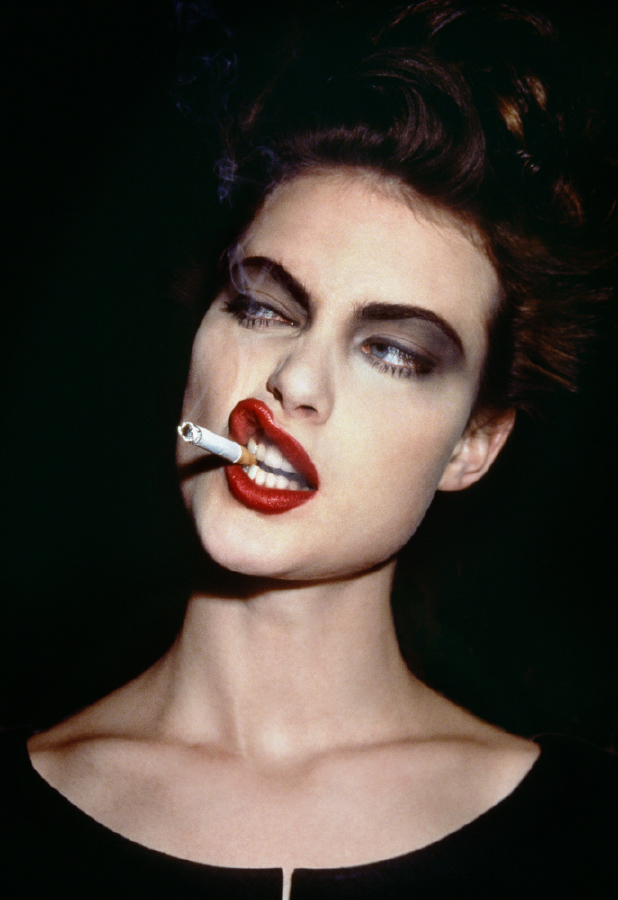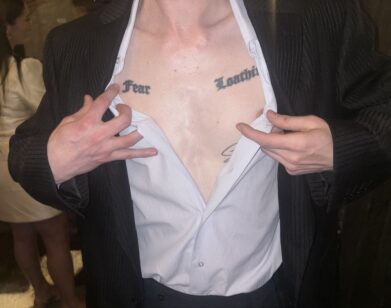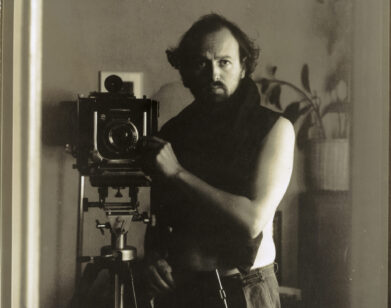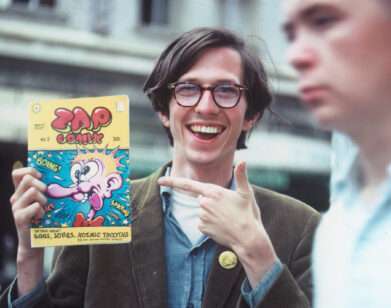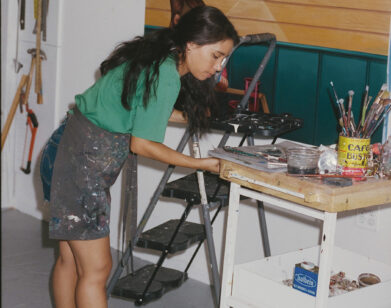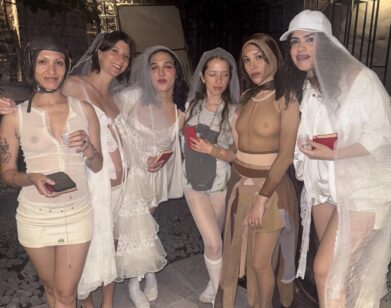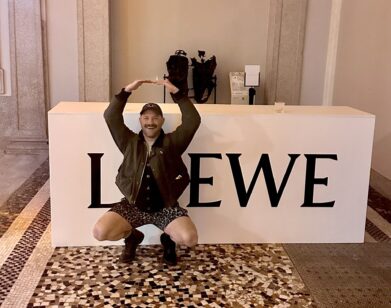What Warhol Learned from Roxanne Lowit
The world has almost caught up with Roxanne Lowit. Almost. For over four decades, the soft-spoken, New York-based photographer has been chronicling the backstage glitz and glamour at fashion shows and nightlife events around the globe with style and effortless panache. On December 12, the Steven Kasher Gallery will feature a mini-retrospective of Lowit’s work, appropriately titled “Roxanne Lowit: Be Fabulous.” The exhibit promises to feature 40 vintage black-and-white photographs and over 20 large-scale color photographs capturing several generations’ worth of artists, tastemakers, A-list actors, designers, supermodels, and even Lowit’s latest collective muse, an outrageous and multi-talented generation of New York City club kids.
In the age of the selfie, Lowit’s particular skill set is all but extinct. Being photographed at society events has become a chore or a blatant act of vain pandering to insatiable social and anti-social media platforms. For Lowit and her subjects, however, the camera is a source of pleasure. Her shots are warm, intimate, and unfailingly natural. Her stark work, which often pushes Rembrandt levels of high contrast, have helped define the enduring haute couture aesthetic. Her portraits seamlessly blend the candid and the choreographed, as Lowit prefers to wield her camera like a silent conductor would his or her baton, orchestrating—if not downright instigating—a surging symphony of strange Dionysian fantasies to play out before her with absolutely no need for verbal instruction.
We caught up with Ms. Lowit over tea and homemade cookies in her apartment that borders Kips Bay and Murray Hill and overlooks the East River. In it, a coffee table languishes underneath a mountain of coffee table books as immortal icons spanning the late ’60s to late last night gaze back unequivocally, as if they were privy to all the magicians’ secrets.
KURT MCVEY: Let’s go back, before your days at FIT. What brought you to that school, and perhaps also to New York City?
ROXANNE LOWIT: I spent about a year in Babylon, Long Island, because my mother moved out there and I was still going to High School. I met a few friends—artsy, creative people. I was a sculptor and a painter, and I looked like I came from Greenwich Village, especially for that area. I had black clothes, black hair, black nails. Now I have red nails. [laughs]
MCVEY: Can you tell me a little bit more about your high school experience? What was Babylon like at the time?
LOWIT: There were always deer in the back yard, but I walked exclusively on the sidewalks. I was a city girl. I’ve never been countrified. But I graduated and ended up going with a friend to FIT.
MCVEY: Who was that?
LOWIT: Jack Geisinger. He passed, but we were friends up until the end. We took a dress design and apparel class, and I realized that I didn’t like it, mostly because I couldn’t sew very well. I then change over to textile design, where I could draw and paint. It was perfect for me. I got to the height of my career as a textile designer. I was working with people like Donna Karan, Jean Muir, and Scott Barrie.
MCVEY: Who was the first person in the fashion world that really recognized something special in you? Who was it that first reached out and gave you a shot?
LOWIT: I think it was really the teachers at FIT. People like Henrietta Rice and so on. In fact, the person who taught me silkscreen was Maxime de la Falaise, Loulou Della de la Falaise’s mother. She was a societal lady at the time.
MCVEY: Did she provide that first intoxicating glimpse into New York’s high society?
LOWIT: I think so.
MCVEY: Were you dazzled?
LOWIT: No, but I was fascinated. I was always fascinated with people and places and seeing things I didn’t know about. It was after graduating, and thriving in silkscreen, when I started taking pictures backstage. Antonio Lopez, who also went to school with us, gave me my first camera.
MCVEY: What kind of camera was it?
LOWIT: It was an Instamatic 110, which meant it had tiny little negatives. Somehow Annie Flanders from the SoHo News heard I was doing pictures and was headed to Paris. She saw my worked, liked it, and asked me to take pictures for her paper while I was there, but told me I would first have to buy a real camera. [laughs]
MCVEY: What camera was that?
LOWIT: 35-millimeter. I got a little book that taught me how to load film. I read it on the flight to Paris. Hours later, I found myself at the top of the Eiffel Tower with Yves Saint Laurent and Andy Warhol. It’s all been downhill since then.
MCVEY: Tell us a little about Warhol.
LOWIT: He loved going out. He was at everything.
MCVEY: Do you consider yourself a voyeur, or are you too involved in the world itself to ever adopt a title of that nature?
LOWIT: I think it depends. Sometimes I’m a voyeur. I love watching people. I also love taking pictures of people who like having their picture taken; Andy Warhol, Salvador Dalí, people like that. I guess I was lucky enough to be in the right places at the right times. But at the same time, as soon as I got my camera, I knew it was my métier.
MCVEY: When you returned from Paris after hanging out with these amazing people, did you feel like you had arrived?
LOWIT: Actually, I kind of expected it all. In fact, when I did my first story for Italian Vogue for Franca Sozzani, she gave me something like 47 full pages, and I was like, That’s all? [laughs] I didn’t know any better.
MCVEY: Many designers and photographers are rather secretive, if not precious, about their methods or their process. Were most people in the industry open to providing you backstage or behind-the-scenes access?
LOWIT: They never brought me in. [laughs]
MCVEY: You had to fight your way in?
LOWIT: I always had to fight. I still do, believe it or not. When I first started taking pictures, I had to go backstage. In New York, they had shows in small showrooms, not in big tents or anything like that. There would always be editors outside, and they would have their own photographers with them. Not fashion photographers, just photographers. They were usually big guys in these ridiculous safari jackets with huge lenses and cameras hanging off everywhere, usually a mess. The editors would say to them, “Take a picture of this or that,” and they would take the picture. The shows existed solely for the editor. Often models would stop at the end of the platform so editors could feel the fabric. Even in Paris, I remember Billie Blair—a great model at the time—had to sneak me in by telling people I was her hairdresser. But her hair was so short, practically shaved. I said, “Couldn’t you say I was your makeup artist?”
MCVEY: [laughs] Being that all these other photographers were so conspicuous with their bravado and all the bells and whistles, did this ever allow you to slip in unnoticed?
LOWIT: No, they would stop me at the door and say, “You can’t be a photographer, you don’t look like one!” Karl Lagerfeld liked that I was little, thin, and totally different. He also liked that I knew fashion. He liked that I could tell a girl to zip up, or that she was wearing the wrong shoes.
MCVEY: Once you started to develop a name for yourself, did you find that models and celebrities started acting differently around you? Did they shy away or perhaps turn on the theatrics when you were around?
LOWIT: No, I feel as though they were always natural. I mean there are some people who just naturally pose, like Dalí. If he saw me reach for my camera, he might pick up someone’s hand and kiss it. I never knew if he was doing it for me, or doing it because he felt like kissing someone’s hand. Either way, it made a great photo.
MCVEY: Has someone like Warhol or Dalí ever said a word or a phrase that’s stuck with you?
LOWIT: Andy once said to me, “I learned something from you.” I said, Really? What? He reaches into both jacket pockets, pulls out two different cameras and goes, “Black and white. Color.” Carrying both a black-and-white camera and a color camera was something I had to do before digital, because for me, certain shots warranted color and some didn’t. Andy started doing that too—carrying two cameras at once. He was always observing. Even me, it seems.
MCVEY: Did you ever get to twirl Dalí’s mustache?
LOWIT: No. [laughs] Silly. Though I might have brushed up against it once while kissing him goodbye. He was so fun to photograph, such an honor really.
MCVEY: You spent 33 years in Greenwich Village…
LOWIT: On Bethune Street, in a great loft.
MCVEY: What has changed the most over the years from your perspective?
LOWIT: Well, probably the Halloween parade. It used to start at The Westbeth, go up two blocks and come back. Now of course, it’s this enormous thing. Halloween is my favorite holiday.
MCVEY: A recent Village Voice had Lou Reed on the cover. On the bottom, it had a lyric from “Halloween Parade”: This Halloween is something to be sure/especially to be here without you. Lou Reed appears in many of your shots, often in that amazing double-breasted leather jacket. The aesthetic that Lou and his contemporaries helped create still influences much of how people glorify the downtown scene. With all the talk of how drastically things have changed, do you think that much of that vibe or sense of nostalgia has definitively passed along with Lou?
LOWIT: Yeah, it’s sort of a marker.
MCVEY: Speaking of how things are different, photography in the digital age has changed dramatically, as you know. Has this affected you at all in anyway?
LOWIT: I still do what I do. I shoot digital, but my process hasn’t changed. I still love taking photos. I have a blog. I have an Instagram. I do them, but I’m not obsessed like everyone else. I’m not on there every 10 minutes. I do think that many people forgot what a great photo looks like.
MCVEY: What makes a great photograph?
LOWIT: Something that is strong, that has a message perhaps, that’s enlightening, or strange. It’s a lot of things that make a good photograph. It’s about the rapport. It’s about capturing the moment. That’s why my first book is called Moments (Vendome Press, 1993). People say I’m a fly on the wall. I don’t like that. Lagerfeld said it better. He said something like, “When I’m there, I’m not noticed. When I’m not there, I’m missed.”
MCVEY: Let’s talk about magic. You use that word often in your books. I think it was Mapplethorpe who loved to say about a certain photo, “That one has the magic!”
LOWIT: You can feel it when you take a magical picture. I told Jean-Michel Basquiat one time, “Oh, I just took a beautiful picture of you,” and he said, “Don’t show it to anybody!” I asked why and he said, “Because I was smoking in it.” Even though it was just a little cigarette. He didn’t want his clients to know that he smoked. I thought it was strange. Three months later he died of an overdose.
MCVEY: Are there other photographers out there that you admire?
LOWIT: I like what David [LaChapelle] does. I think he’s innovative, and crazy. Good crazy. [laughs] I like [Helmut] Newton and [Irving] Penn. They were originals. I like Weegee. Do you know Weegee? He would follow the police around with his huge camera and rearrange dead bodies at crime scenes. Of course, you can’t do that anymore. His other stuff was very much what I liked to do. Besides the dead bodies, we’re sort of kindred spirits.
MCVEY: Let’s talk about your upcoming show at the Steven Kasher Gallery. Are you approaching this show differently from past shows?
LOWIT: Steven suggested I show a lot of things together. I’ve always shown either my people, or my backstage. At first I didn’t agree, but then I thought, why not do a big mixed show? I’m actually curious to see how it all looks together. I want this show to tell a story. I always say, my pictures are my words.
MCVEY: Recently you’ve been shooting performers from this generation’s club scene. Do you recognize how instrumental you are to their world and their general fabulousness? They put so much energy and time into their outfits; it’s almost like a tree falling in the forest and you’re there to hear it.
LOWIT: Or record it. You know, some of these kids take two to three hours to get ready. So that’s where I am at night— Greenhouse, On Top with Susan Bartsch, Marquee—it’s so energizing for me. Everyone says, “Aren’t you exhausted, aren’t you tired, you worked all day and now you’re heading out after midnight to take pictures?” The answer is no. They’re so inspiring. They fill me with life.
MCVEY: Have you ever dressed up?
LOWIT: I was a monkey for Halloween.
MCVEY: What kind of monkey?
LOWIT: A big one. [laughs]
“ROXANNE LOWIT: BE FABULOUS” OPENS AT STEVEN KASHER GALLERY ON DECEMBER 12 AND RUNS THROUGH JANUARY 12.

